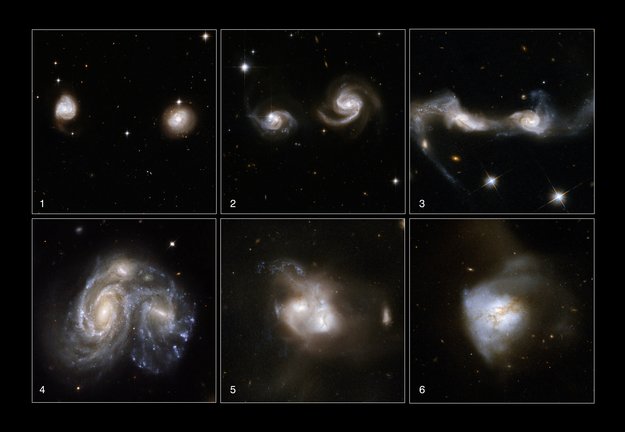Galaxies are not static, isolated islands of stars—they live dynamic lives, constantly influenced by gravity and their surroundings. One of the most significant events in a galaxy’s evolution is a galactic merger, when two or more galaxies interact and combine under their mutual gravitational attraction.
How Galaxy Mergers Occur
Mergers are common because galaxies typically reside in groups or clusters, not in isolation. Over time, gravitational forces between neighboring galaxies can pull them toward one another. As they approach, tidal forces distort their shapes, pulling out long streams of stars and gas called tidal tails. These interactions can span hundreds of millions of years and eventually result in the galaxies coalescing into a single, larger galaxy.
Effects of Mergers
Starbursts: The collision compresses gas clouds, triggering intense star formation. These episodes are called starbursts and can rapidly convert large amounts of gas into stars.
Morphological Changes: Mergers often transform spiral galaxies into elliptical galaxies, especially in major mergers (between galaxies of similar size). The disk structure is typically disrupted.
Supermassive Black Holes: Nearly all large galaxies host a supermassive black hole at their center. During a merger, the central black holes may also spiral inwards and eventually merge. As gas falls into these black holes, it can power active galactic nuclei (AGN)—extremely luminous centers that emit across the electromagnetic spectrum.
Gas Redistribution: Mergers can funnel gas toward the galactic center, feeding black holes and altering future star formation.
Our Future: The Milky Way and Andromeda
One of the most famous upcoming mergers is between the Milky Way and the Andromeda Galaxy (M31). These two large spiral galaxies are currently about 2.5 million light-years apart and are moving toward each other at roughly 110 km/s. In about 4 billion years, they will begin to collide. Over time, they will likely merge into a single elliptical or lenticular galaxy, sometimes nicknamed “Milkomeda”.
Now read the Chapter The Evolution and Distribution of Galaxies in the Openstax Astronomy textbook.
Self-Evaluating Questions
Try answering these questions after completing the reading. If you find any difficult to answer, revisit the textbook to reinforce your understanding.
-
a) The galaxies immediately collapse into a black hole
b) The galaxies maintain their original spiral structures
c) Intense star formation, known as a starburst, occurs
d) The galaxies stop interacting and remain unchanged -
a) The black holes remain unaffected by the merger
b) The black holes move apart and leave the galaxies
c) The black holes spiral inward and may eventually merge
d) The black holes eject all nearby stars from the galaxy -
a) Globular clusters
b) Tidal tails
c) Supernovae
d) Dark matter filaments -
a) Mergers cause the ordered motion of stars in a spiral disk to become more random
b) The black holes at the centers of the galaxies consume all the spiral arms
c) The spiral arms of the colliding galaxies fuse together into a ring
d) Mergers prevent any further star formation, leaving only old stars -
c
c
b
a

